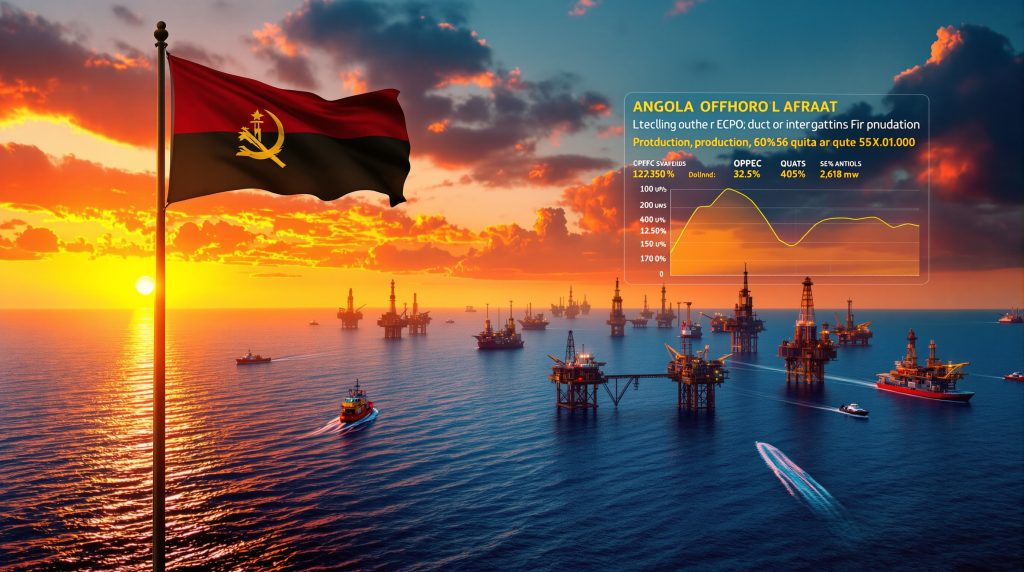The Strategic Miscalculation Behind Angola's OPEC Exit
Angola's departure from OPEC in January 2024 represented one of the most significant shifts in global oil politics in recent years. After 16 years of membership, the West African nation chose to abandon collective market coordination in favor of unilateral production decisions. The Angola OPEC exit followed mounting tensions over production quotas that Luanda deemed incompatible with its economic development goals.
The catalyst emerged when OPEC+ imposed a 1.11 million barrel per day production ceiling for 2024, representing a substantial reduction from Angola's preferred output levels. Government officials viewed these constraints as economically damaging and fundamentally at odds with their strategy to maximise petroleum revenues during a period of aging infrastructure and declining reserves.
Primary drivers of the withdrawal included:
- Production quotas below actual capacity utilisation
- Investment restrictions limiting sector modernisation
- Conflicts between national revenue objectives and cartel discipline
- Desire for autonomous energy policy decision-making
Production Performance Falls Short of Expectations
The aftermath of Angola's OPEC exit has revealed uncomfortable truths about the country's petroleum sector. Despite gaining freedom from production constraints, output has continued its downward trajectory, reaching levels not seen since before OPEC membership began in 2007.
Key production metrics post-departure:
| Period | Production Level | Trend |
|---|---|---|
| Pre-Exit (2023) | 1.1 million b/d | Declining |
| Mid-2024 | Below 1.0 million b/d | Further decline |
| 2025 | Sub-1.0 million b/d | Historical lows |
The stagnation stems from geological realities rather than organisational restrictions. Angola's offshore production base faces advanced depletion rates across major field complexes, with the flagship Kizomba development showing 85% depletion despite continued operation by ExxonMobil.
Export data provides clear insight into production trends since Angola processes minimal crude domestically. With only the 65,000 barrel per day Luanda refinery operational during most of this period, seaborne shipments effectively mirror total output. These exports have remained flat at approximately 1.1 million barrels daily since 2021, confirming that quota elimination failed to stimulate increased production.
Structural Challenges Dominate Production Outlook
Angola's petroleum industry confronts multiple interconnected obstacles that extend far beyond OPEC membership considerations. These fundamental constraints have proven more significant than quota restrictions in limiting production growth potential.
Geological constraints affecting output:
- Mature offshore fields experiencing natural decline curves
- High depletion rates across flagship developments
- Limited major discoveries to offset reservoir aging
- Expensive deepwater extraction requirements increasing operational costs
Of Angola's 20 largest producing fields, only five remain below the critical 70% depletion threshold. This concentration of mature assets creates significant challenges for maintaining production levels without substantial additional investment in enhanced recovery techniques or infill drilling programmes.
Investment climate barriers include:
- Historically unfavourable fiscal regimes discouraging new capital
- High government revenue participation through royalties and profit-sharing
- Rigid cost-recovery limitations constraining operator flexibility
- Competition from lower-cost global production centres
The Block 15 Kizomba complex, operated by ExxonMobil and producing approximately 200,000 barrels daily, exemplifies these challenges. Despite its status as a flagship development, the project has reached 85% depletion, requiring increasingly sophisticated and expensive recovery methods to maintain output levels.
Investment Framework Transformation Attracts Capital
Recognising that OPEC constraints were not the primary obstacle to sector growth, Angola implemented comprehensive fiscal reforms through the Incremental Production Decree in November 2024. This legislative overhaul targeted the investment climate issues that had discouraged international capital participation.
Reformed fiscal structure comparison:
| Previous Framework | New Structure | Impact |
|---|---|---|
| 20% royalty rate | 15% royalty rate | Reduced government take |
| Variable profit-oil sharing | 25% maximum ANPG share | Predictable returns |
| Limited cost recovery | 70% cost-recovery ceiling | Enhanced cash flow |
| No exploration cost recovery | Failed well cost recovery | Risk mitigation |
These modifications specifically targeted mature and undeveloped acreage, ensuring incentives reached aging assets requiring additional investment for continued production. The reforms also introduced clearer classification systems for different acreage types, allowing operators to understand applicable fiscal terms before committing resources.
Major Operators Respond to Reformed Investment Climate
The improved fiscal environment successfully attracted both established producers and new market entrants to Angola's petroleum sector. International companies expanded their commitments while smaller independents entered previously inaccessible markets.
Significant investment developments:
- Chevron: Signed risk service contract for Block 33 in September 2025
- TotalEnergies: Commissioned Clov Phase 3 project adding 30,000 barrels daily
- Shell: Returned to Angola after 20-year absence with Block 33 exploration agreement
- Afentra PLC: Acquired stakes in Blocks 3/05 and 3/05A for onshore revival projects
Current major operators maintaining substantial production include:
- Azule Energy (BP-Eni joint venture): 230,000 barrels daily
- Sonangol (state company): 200,000 barrels daily
- ExxonMobil: Continued Kizomba complex operations
- TotalEnergies: Expanded deepwater portfolio management
The Azule Energy joint venture, formed in 2022 between BP and Eni, has emerged as Angola's largest private sector producer. This consolidation reflects industry trends toward operational efficiency and risk sharing in mature offshore environments.
Refining Capacity Development Remains Limited
Angola's downstream petroleum infrastructure has historically lagged behind upstream production capabilities, creating missed opportunities for domestic value addition and fuel security. Recent developments show progress, though significant challenges persist.
Operational refining capacity:
| Facility | Capacity | Status |
|---|---|---|
| Luanda refinery | 65,000 b/d | Primary operational facility |
| Cabinda refinery Phase 1 | 30,000 b/d | Commissioned September 2025 |
| Chevron Cabinda topping plant | Small scale | Limited processing |
Planned downstream projects:
- Cabinda Phase 2: Additional 30,000 barrels daily capacity targeted for 2028
- Lobito refinery: 200,000 barrel daily project facing financing challenges
- Soyo plant: 100,000 barrel daily capacity experiencing ownership disputes
The Cabinda refinery, a joint venture between Gemcorp (90%) and Sonangol (10%), represents Angola's first major downstream addition in decades. Initial operations focus on diesel production, which accounts for approximately 60% of domestic fuel demand, reducing import dependency for this critical product.
Global Market Impact and OPEC Dynamics
Angola's withdrawal reduced OPEC membership from 13 to 12 countries, altering organisational dynamics and diminishing African representation within the cartel. However, immediate market effects have been minimal due to Angola's ongoing production challenges. Furthermore, the OPEC production impact has been less significant than initially anticipated.
Market implications include:
- Reduced collective OPEC production capacity
- Weakened cartel influence over African petroleum policy
- Potential precedent for member nation dissatisfaction
- Limited immediate supply disruption due to output decline
Broader significance encompasses:
- Demonstration of quota-based market management limitations
- Highlighting tensions between national interests and collective action
- Reflecting evolving global oil governance structures
- Emphasising investment climate importance over organisational membership
The timing of Angola's OPEC exit coincides with challenging global market conditions. Accelerating non-OPEC production growth, particularly from American shale and offshore developments, has created supply abundance that industry analysts expect to persist through at least mid-2026. This environment particularly pressures higher-cost producers operating in Angola's deepwater offshore environment, influencing broader oil market trends.
How Did Angola's OPEC Exit Compare to Other Policy Shifts?
Angola's departure from OPEC stands in stark contrast to other significant energy policy changes globally. Unlike the United States' Alaska policy shift which aimed to increase domestic production through regulatory changes, Angola's move reflected disagreements over international coordination mechanisms.
The exit also differs from trade-related energy impacts, such as those from Trump tariffs and OPEC dynamics. While tariffs create external market pressures, Angola's withdrawal represented an internal organisational decision based on production autonomy desires.
Long-term Energy Sector Prospects and Challenges
Despite current obstacles, Angola possesses significant untapped petroleum resources and potential for sector revitalisation. Success depends on sustained policy reform implementation and strategic investment attraction across multiple development phases.
Resource endowment indicators:
- 7.8 billion barrels proven oil reserves (18th globally)
- Numerous undeveloped offshore exploration blocks
- Natural gas development opportunities in associated and non-associated fields
- Approximately 16 years of reserves at current production rates
Strategic development priorities:
- Diversification into natural gas production and export
- Enhanced recovery implementation across mature field complexes
- Frontier acreage exploration in underexplored basins
- Downstream processing capacity expansion for value addition
Critical investment requirements:
- Continued fiscal reform implementation and refinement
- Transportation and processing infrastructure development
- Technology transfer facilitation for advanced recovery methods
- Regulatory framework stability and transparency enhancement
The average breakeven cost for Angolan deepwater offshore production ranges around $40 per barrel, compared to $30-35 per barrel for competing developments in Guyana and Brazil. This cost disadvantage limits Angola's competitiveness in current market conditions and requires operational efficiency improvements, particularly given the latest crude oil price update.
Market Psychology and Investment Sentiment
Industry analysts note that Angola's OPEC exit represented more psychological than practical significance for international investors. The real attraction has been domestic policy reform rather than organisational independence, suggesting that investment climate trumps political positioning in capital allocation decisions.
Investor sentiment factors:
- Fiscal regime predictability more important than quota freedom
- Geological risk assessment primary in investment decisions
- Operational cost structure critical for project economics
- Government partnership approach influences long-term planning
The risk service contract model adopted for Block 33 represents a compromise between traditional production sharing and service agreement structures. This approach provides operators with cost recovery certainty while maintaining government participation in upside potential.
Comparative Analysis with Regional Producers
Angola's experience contrasts sharply with other African oil producers who maintained OPEC membership while implementing competitive fiscal reforms. Countries like Nigeria and Equatorial Guinea have managed quota compliance while attracting investment through targeted incentive programmes.
Regional production trends:
| Country | OPEC Status | 2024 Production | Trend |
|---|---|---|---|
| Nigeria | Member | 1.3 million b/d | Stable |
| Angola | Former Member | <1.0 million b/d | Declining |
| Equatorial Guinea | Member | 0.12 million b/d | Stable |
This comparison suggests that OPEC membership need not preclude investment attraction or production optimisation, provided appropriate domestic policies support industry development objectives. However, Angola's decision to leave OPEC was primarily driven by disagreements over production quotas rather than investment concerns.
Future Scenarios and Strategic Options
Angola's petroleum sector faces several potential development pathways depending on policy implementation, investment attraction success, and global market evolution. Each scenario presents different implications for production trajectory and economic impact.
Optimistic scenario elements:
- Successful fiscal reform implementation attracts major new investments
- Enhanced recovery projects extend mature field productive life
- Natural gas development provides alternative revenue streams
- Downstream capacity expansion creates domestic value addition
Pessimistic scenario risks:
- Continued production decline overwhelms investment efforts
- Global market conditions discourage high-cost developments
- Infrastructure constraints limit operational efficiency improvements
- Political instability undermines long-term investor confidence
Most likely outcome characteristics:
- Gradual production stabilisation around current levels
- Selective investment in highest-return projects
- Limited major new discoveries in near term
- Evolutionary rather than transformational sector development
Technology and Innovation Imperatives
Advanced recovery technologies represent Angola's most promising avenue for production stabilisation and potential growth. International operators bring expertise in enhanced oil recovery, digital optimisation, and subsea system efficiency improvements.
Critical technology applications:
- Water injection optimisation for mature reservoir management
- Subsea processing systems reducing surface infrastructure requirements
- Digital twin modelling for reservoir performance prediction
- Enhanced oil recovery techniques extending field productive life
The Block 15 Kizomba complex serves as a testing ground for advanced recovery methods, with ExxonMobil implementing sophisticated water injection and pressure maintenance systems to sustain production from highly depleted reservoirs.
Environmental and Social Considerations
Angola's petroleum sector development increasingly incorporates environmental protection and social responsibility considerations. International operators face growing pressure to demonstrate sustainable practices and community engagement in project implementation.
Key sustainability factors:
- Marine environment protection in offshore operations
- Local content development and employment creation
- Revenue transparency and community benefit sharing
- Carbon emission reduction and climate impact mitigation
The Cabinda region exemplifies these challenges, where offshore petroleum operations must balance economic development with environmental conservation and local community interests. In addition, Angola's rising oil exports have validated the country's decision to pursue independent production strategies.
Conclusion: Independence Without Recovery
Angola's departure from OPEC represents a strategic calculation that has yet to deliver anticipated benefits. While the country successfully regained autonomy over production policy, fundamental industry challenges have prevented the expected output recovery that motivated the withdrawal decision.
The genuine breakthrough emerged through domestic fiscal policy reform rather than organisational independence. Angola's Incremental Production Decree has successfully attracted renewed international investment interest, though activity focuses primarily on extending mature field productive life rather than discovering transformational new reserves.
Looking forward, Angola's energy sector future depends more on geological realities, investment climate competitiveness, and operational efficiency than on organisational affiliations. The Angola OPEC exit demonstrates that political independence from international organisations cannot overcome structural industry challenges without comprehensive domestic reform and sustained international capital investment.
Disclaimer: This analysis is based on publicly available information and industry reports. Oil and gas production figures, investment projections, and market forecasts involve inherent uncertainties and should not be considered as financial advice. Readers should conduct independent research and consult qualified professionals before making investment decisions related to Angola's petroleum sector or similar emerging market opportunities.
Ready to Capitalise on Africa's Energy Market Opportunities?
Whilst Angola's petroleum sector faces challenges, Africa's resource markets continue to present significant opportunities for informed investors. Discovery Alert's proprietary Discovery IQ model instantly identifies major mineral discoveries across the ASX, including companies with African exposure, helping subscribers spot actionable opportunities before broader market recognition. Begin your 30-day free trial today and position yourself ahead of the market with real-time alerts powered by advanced AI technology.




